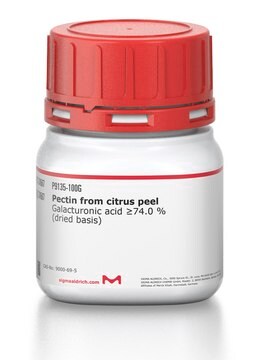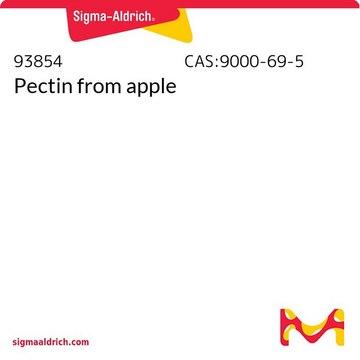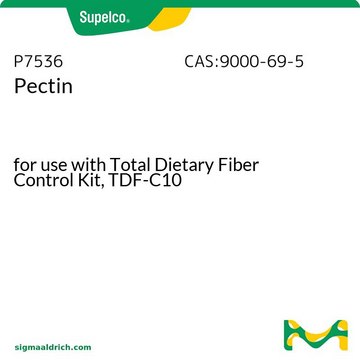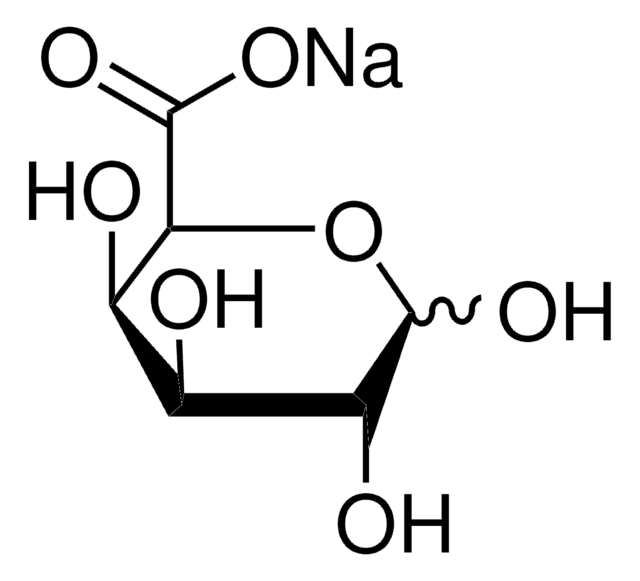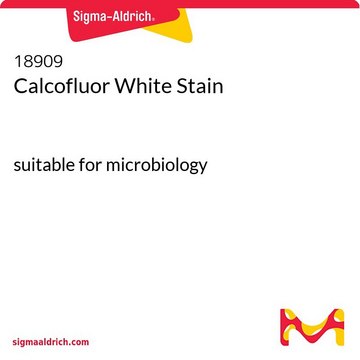P3889
Polygalacturonic acid
≥85% (titration), from oranges
Sign Into View Organizational & Contract Pricing
All Photos(1)
About This Item
Linear Formula:
(C6H8O6)n
CAS Number:
MDL number:
UNSPSC Code:
12352201
NACRES:
NA.25
Recommended Products
biological source
oranges
Assay
≥85% (titration)
form
powder
color
white to brown
mp
60 °C
solubility
aqueous NaOH: 1%, clear to hazy
storage temp.
room temp
SMILES string
O1[C@@H]([C@@H]([C@H]([C@H]([C@H]1C(=O)O)O)O)O)O
InChI
1S/C6H10O7/c7-1-2(8)4(5(10)11)13-6(12)3(1)9/h1-4,6-9,12H,(H,10,11)/t1-,2+,3+,4-,6-/m0/s1
InChI key
AEMOLEFTQBMNLQ-BKBMJHBISA-N
Looking for similar products? Visit Product Comparison Guide
General description
Polygalacturonic acid is composed of galacturonic acid unit arranged as a long polymer chain. Methyl esters of polygalacturonic acid forms pectin.
Application
Polygalacturonic acid has been used:
- in the preabsorption of 2F4 primary antibody solution
- as a substrate to determine polygalacturonase activity
- in the preparation of oligogalacturonates mixture which is used as a substrate to determine the specificities of different acetylesterases
Polygalacturonic acid sequesters metal ions. It also produces gels in the presence of Ca2+ that can be used for drug release or to immobilize cells or enzymes for the production of biomolecules.
Biochem/physiol Actions
In land plants, polygalacturonic acids are major components of cell wall polysaccharides (pectins). Bound polygalacturonase-inhibiting peptides (PGIP) protect pectin from degradation by fungal polygalacturonases.
Other Notes
To gain a comprehensive understanding of our extensive range of Polysaccharides for your research, we encourage you to visit our Carbohydrates Category page.
Storage Class Code
11 - Combustible Solids
WGK
WGK 3
Flash Point(F)
Not applicable
Flash Point(C)
Not applicable
Personal Protective Equipment
dust mask type N95 (US), Eyeshields, Gloves
Choose from one of the most recent versions:
Already Own This Product?
Find documentation for the products that you have recently purchased in the Document Library.
Customers Also Viewed
Mouyong Zou et al.
PloS one, 8(11), e79357-e79357 (2013-11-16)
An alkaline polygalacturonate lyase (PGL) from Bacillus subtilis 7-3-3, PelC, with diverse depolymerization abilities for different pectin substrates was found. The PGL activity of PelC decreased with increasing degree of methyl esterification of the substrate. PelA and PelC displayed notable
Biotechnology for Livestock Production, 246-246 (1989)
L Kurillová et al.
Journal of microencapsulation, 17(3), 279-296 (2000-05-20)
The structure of standard and stabilized calcium pectate gel (CPG) beads has been examined by scanning (SEM) and transmission (TEM) electron microscopy. A two-stage crosslinking procedure with polyethyleneimine (PEI) and glutaraldehyde (GA) led to the formation of a more compact
Bacterial Wilt Disease: Molecular and Ecological Aspects, 171-171 (1998)
Zhangyong Dong et al.
BMC biochemistry, 12, 51-51 (2011-09-17)
Fusarium wilt is an economically devastating disease that affects banana production. Although Cavendish banana cultivars are resistant to Fusarium oxysporum f.sp. cubense race 1 (FOC1) and maitain banana production after Gros Michel was destructed by race 1, a new race
Protocols
Enzymatic Assay of Pectinase
Our team of scientists has experience in all areas of research including Life Science, Material Science, Chemical Synthesis, Chromatography, Analytical and many others.
Contact Technical Service